Finding the perfect fast-growing plants for your aquarium is an exciting and fun task, but the challenge begins when you don’t know which plants to choose. The plant market offers you many options, and it can seem overwhelming to find a selection that works for you. However, we’re here to help!
Our quick and simple guide will walk you through a list of the top ten plants fastest-growing aquarium plants! The wide range of plants we’re covering includes plants that will thrive in different aquarium sizes; you need not worry about not being able to find a plant that doesn’t suit your lifestyle.
Keep reading for more information and a buying guide at the end!
Table of Contents
10 Fastest-Growing Aquarium Plants
1. Water Wisteria
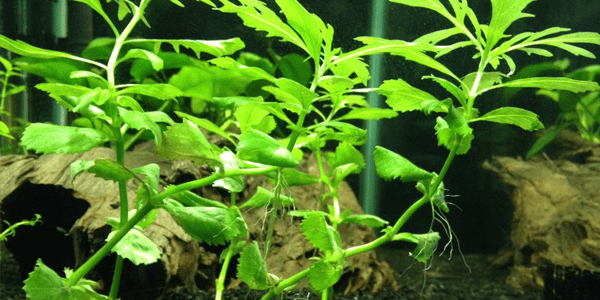
Our first pick is the water wisteria plant. This beautiful plant is perfect for people with huge aquariums that need giant plants to fill the space! They are scientifically known as Hygrophila difformis, indicating that they belong to the larger Hygrophila species of plants. They are highly fast-growing and low-maintenance plants, making them an ideal choice. We think that these plants work exceptionally well for people with busy schedules who still want their aquariums to look lovely. It absorbs nutrients very well and grows taller every day. One of the most exciting features of water wisteria is that the color of its leave change in response to varying light levels. Its leaves turn dark green when the light is low, and they become a lighter shade of green when the light levels change.
Please take note of the following plant requirements:
- Growth Rate: Its growth rate is very fast.
- Max Height: It can grow to a maximum height of 14 to 20 inches.
- Light Demands: It requires low to moderately high levels of lighting.
- Temperature: 75° to 82° F.
- CO2 required: Additional CO2 isn’t necessary, but this plant responds positively to CO2 injections.
2. Anacharis
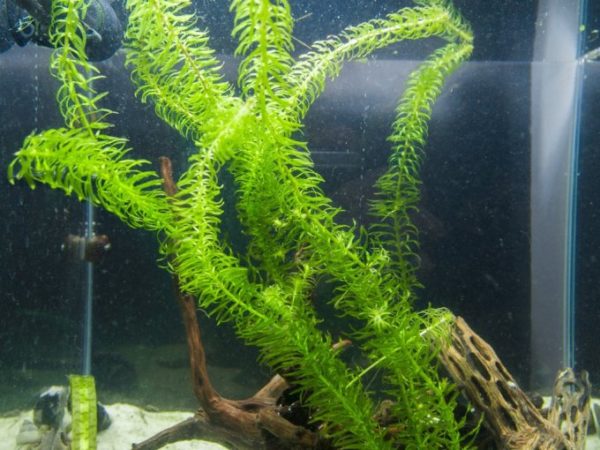
The second, fastest-growing aquarium plant is Anacharis. Many refer to it by its generic name, Brazilian waterweed, or its scientific name, Elodea Densa. This plant is easy to care for and is perfect for beginners taking care of an aquarium! We love this plant because of how low-maintenance and affordable it is. One of the best features of this plant is that it thrives in cooler climates, making it the ideal piece of greenery to add to your aquarium if you live in a cold place. We highly recommend that you don’t purchase this plant if you have cichlids or goldfish. Those vegetarian fish love Brazilian waterweeds, meaning that they might not give it the chance to grow tall!
Please take note of the following plant requirements:
- Growth Rate: Its growth rate is fast.
- Max Height: It can grow to a maximum height of eight to 12 inches.
- Light Demands: This plant requires low to high levels of light.
- Temperature: It requires 60° to 75° F.
- CO2 required: It does not need additional CO2 to survive.
3. Duckweed
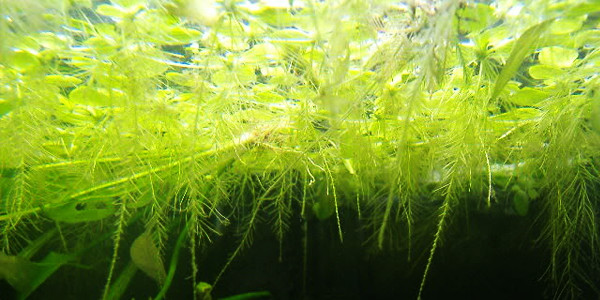
If you have a little extra time on your hands and want to take care of a high-maintenance plant, then duckweed might be what you’re looking for! Even though its generic name might make you think of a farmyard, its scientific name, Lemna Minor, will dispel those ideas. Unlike some common aquatic plants, duckweed does not grow roots or stems. Instead, these plants float at the top of the fish tank! They grow so quickly because they have direct access to sunlight and carbon dioxide simultaneously, allowing them to photosynthesize easily. We’d recommend that you pair duckweed with plants that don’t require high lighting levels because duckweed grows rapidly. It covers the surface of the tank, preventing light from penetrating.
Please take note of the following plant requirements:
- Growth Rate: Its growth rate is fast.
- Max Height: Duckweed doesn’t grow to a height because it doesn’t have roots or stems.
- Light Demands: It requires medium to high levels of light.
- Temperature: It requires 68° to 86° F.
- CO2 required: It does not need additional CO2 to survive.
4. Hornwort
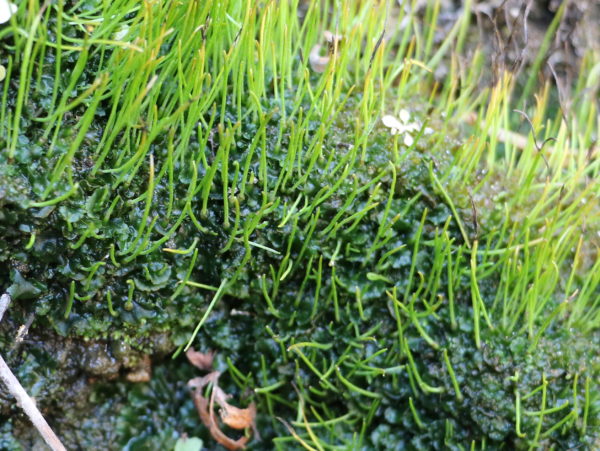
Our next pick is the hornwort plant. It is a beautiful choice for people with giant aquariums who need a plant to fill up the space quickly. One of the reasons we love this plant so much is because hornwort is incredibly easy to maintain. It’s also quite versatile, which means that it doesn’t require precise water temperatures or lighting levels to survive. This plant is a column feeder, which means that it floats and doesn’t take root in the substrate. However, please note that you can plant a hornwort plant in the substrate. In order to make sure that this plant grows very tall, it would be best to add a liquid fertilizer before planting hornwort in your aquarium.
Please take note of the following plant requirements:
- Growth Rate: Its growth rate is fast.
- Max Height: Hornwort can grow up to six feet tall.
- Light Demands: It requires low to high levels of light.
- Temperature: It requires 50° to 85° F.
- CO2 required: It does not need additional CO2 to survive.
5. Amazon Sword
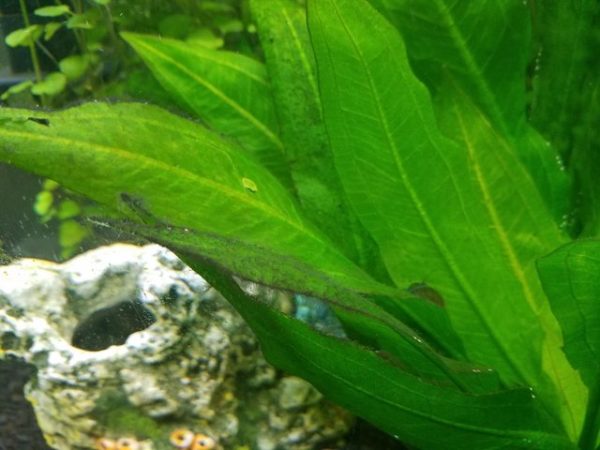
The Amazon Sword is the perfect plant for when you have a giant aquarium and need something beautiful to fill the space. While its generic name sounds like a weapon, this plant’s scientific name is Echinodorus bleheri. We love the Amazon sword plant because it is easy to keep healthy, thanks to the fact that it adjusts easily to varying water temperatures. Many consider this plant an underwater palm because of its tall, thin body and long thin leaves. Since it is a fast-growing plant, we recommend that you keep a close eye on it so that it doesn’t outgrow the other plants in your aquarium.
Please take note of the following plant requirements:
- Growth Rate: Its growth rate is fast.
- Max Height: Amazon sword plants can grow up to 2 feet tall.
- Light Demands: It requires low to medium levels of light.
- Temperature: It requires 72° to 82° F.
- CO2 required: It does not need additional CO2 to survive.
6. Dwarf Sagittaria

If you have a small aquarium that needs a plant to cover the substrate quickly, dwarf Sagittaria is the ideal choice. We’re recommending this plant to the owners of small tanks because, as the plant’s name suggests, dwarf Sagittaria is a short plant. It grows quickly and resembles grass. Its scientific name is Sagittaria Subulata and does a beautiful job of providing your aquarium with a carpet along the bottom of the tank. Dwarf Sagittaria helps keep the ammonia levels of the aquarium in check, and it is also relatively easy to maintain.
Please take note of the following plant requirements:
- Growth Rate: Its growth rate is fast.
- Max Height: It can grow to up to one foot tall.
- Light Demands: It requires low to medium levels of light.
- Temperature: It requires 72° to 82° F.
- CO2 required: It does not need additional CO2 to survive.
7. Micro Sword
Next up on our list is the micro sword, known scientifically as Lilaeopsis brasiliensis. Unlike most of the other options listed above, this plant isn’t as easy to care for or maintain. However, if you want to take on the challenge of looking after a plant with specific requirements, this is the option for you! This plant grows relatively fast and is long-lasting, but please note that it won’t live as long as you would like if you don’t provide it with proper care. It requires bright light and regular water changes. We recommend this plant to people with flexible schedules.
Please take note of the following plant requirements:
- Growth Rate: Its growth rate is fast.
- Max Height: It can grow to a maximum height of three inches.
- Light Demands: It requires high lighting levels.
- Temperature: It requires 70° to 83° F.
- CO2 required: It does needs CO2 injections to survive.
8. Java Moss
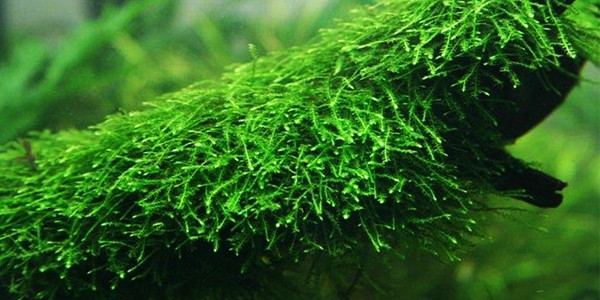
As we near the end of our list, we’re recommending fuss-free plants for people with busy lives. Java moss is one of those plants that are ideal for people who don’t want to spend too much time worrying about their aquatic plants. This plant’s scientific name is Vesicularia dubyana. One of the best features of this plant is that you don’t have to worry about where it needs to be placed in the tank. This means that you can let it float or attach it to a rock with a piece of thread. If you let it sit at the bottom of the tank, the java moss will provide baby fish with protection and shelter.
Please take note of the following plant requirements:
- Growth Rate: Its growth rate is fast.
- Max Height: It can grow to a maximum height of ten inches.
- Light Demands: It requires low to high lighting levels.
- Temperature: It requires 70° to 75° F.
- CO2 required: CO2 injections aren’t necessary, but we recommend injections every so often.
9. Green Foxtail
Our next pick is the green foxtail. If you want your aquarium to look aesthetically pleasing, then this is the plant for you. Scientifically, this plant is known as Setaria viridis, and it is excellent for tall aquariums. It is relatively easy to care for, mainly thanks to the moderate lighting levels and temperatures it needs to survive. While this plant is entirely hands-off, we highly recommend that you take note of its fast growth rate. It grows extremely fast and needs to be pruned every so often to prevent it from taking up too much space inside the aquarium.
Please take note of the following plant requirements:
- Growth Rate: Its growth rate is fast.
- Max Height: It can grow to a maximum height of four feet tall.
- Light Demands: It requires moderate to high lighting levels.
- Temperature: It requires 60° to 86° F.
- CO2 required: CO2 injections aren’t necessary, but we recommend injections every so often.
10. Dwarf Four Leaf Clover
Our final recommendation is the dwarf four-leaf clover. Hailing from Australia, this plant requires low care levels, allowing you to get on with the rest of your day without worry. We love this plant because its growth rate is moderate to fast, depending on the aquarium’s conditions and the requirements of the other plants living in the space. While you won’t always be able to find four-leaved clovers in your aquarium, we’re certain that when you do, it’ll bring you good luck when you do!
Please take note of the following plant requirements:
- Growth Rate: Its growth rate is moderate to fast.
- Max Height: It can grow to a maximum height of two to three inches tall.
- Light Demands: It requires medium to high lighting levels.
- Temperature: It requires 64° to 84° F.
- CO2 required: It does not need regular CO2 injections.
How to take care of fast-growing plants?
When it comes to taking care of fast-growing plants, several factors to keep in mind, some of them are as follows:
Keep spacing in mind.
Since these plants tend to grow very quickly, you need to keep the amount of space in your tank in mind. What we mean by this is that you must remember that you might have other plants that have different temperature and lighting requirements. If you have a fast-growing plant, it could take up more space than necessary and inhibit the other plants from functioning normally.
Use liquid fertilizers.
While you might not want to, it would be best to add liquid fertilizer to your aquarium so that the fast-growing plants don’t consume all the nutrients in the tank and prevent the other plants from growing properly.
Buying Guide
When buying fast-growing plants, keep the following points in mind:
- If you’re adding new plants to an existing tank, consider your other plants’ nutritional and temperature-based needs so that you don’t buy a plant whose requirements clash with your existing plants.
- Keep the size of your tank in mind. Don’t buy a plant that grows tall very fast if you have a short or small tank.
Wrapping up
This article took you through a list of ten of the best and fastest-growing aquarium plants on the market. We walked you through a wide variety of plants with varying requirements, making sure to find plants that work for many different aquariums and people!
